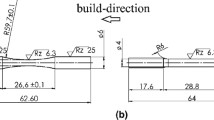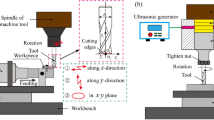Abstract
Modeling is carried out of the discrete plastic deformation of the rough surface of a metal part by a sliding rigid tool with a circular profile. This modeling is based on the theory of the plane deformation of a perfectly plastic solid taking into account the Prandtl contact friction. The number of discrete contacts and the plastic stress–strain state are determined by the periodic shape of the rough surface, as well as the radius and the vertical displacement of the tool with regard to asperity summits. The plastic smoothing mode used to reduce the surface roughness without the deformation of the core of the metal part is considered.
Similar content being viewed by others
References
Mashinostroenie. Entsiklopediya. T. III-3. Tekhnologiya izgotovleniya detalei mashin (Mechanical Engineering. Encyclopedia. Vol. III-3. Technology of Machine Detail Production), Moscow: Mashinostroenie, 2006.
Odintsov, L.G., Uprochnenie i otdelka detalei poverkhnostnym plasticheskim deformirovaniem. Spravochnik (Hardening and Finishing of Details by Surface Plastic Deformation. A Handbook), Moscow: Mashinostroenie, 1987.
Grigorev, S.N., Kovalev, O.B., Kuzmin, V.I., Mikhal’chenko, A.A., Fomin, V.M., Rudenskaya, N.A., and Sokolova, N.G., New possibilities of plasma spraying of wear-resistant coatings, J. Friction Wear,2013, vol. 34, pp. 161–165.
Nepershin, R.I., On rolling and sliding of a cylinder along a perfectly plastic half-space with allowance for contact friction, Dokl.-Phys.,2002, vol. 47, pp. 256–258.
Nepershin, R.I., Cylinder rolling and sliding on the boundary of the rigid-plastic half-space, Prikl. Math. Mekh.,2003, vol. 67, pp. 326–335.
Drozdov, Yu.N., Yudin, E.G., and Belov, A.I., Prikladnaya tribologiya (trenie, iznos, smazka) (Applied Tribology (Friction, Wear, Lubrication), Moscow: Eko, 2010.
Hill, R., The Mathematical Theory of Plasticity, Oxford: Oxford Univ., 1985.
Sokolovskii, V.V., Teoriya plastichnosti (Teory of Plasticity), Moscow: Vysshaya Shkola, 1969.
Ishlinskii, A.Yu. and Ivlev, D.D., Matematicheskaya teoriya plastichnosti (Mathematical Theory of Plasticity), Moscow: Fizmatlit, 2001.
Druyanov, B.A. and Nepershin, R.I., Problems of Technological Plasticity, Amsterdam: Elsevier, 1994.
Author information
Authors and Affiliations
Corresponding author
Additional information
Original Russian Text © R.I. Nepershin, 2015, published in Trenie i Iznos, 2015, Vol. 36, No. 4, pp. 384–393.
About this article
Cite this article
Nepershin, R.I. Plastic deformation of rough surface by a sliding tool. J. Frict. Wear 36, 293–300 (2015). https://doi.org/10.3103/S1068366615040108
Received:
Published:
Issue Date:
DOI: https://doi.org/10.3103/S1068366615040108




